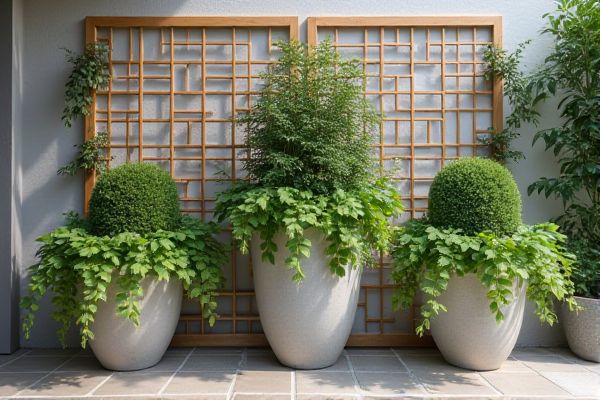
Planters with trellis provide vertical support for climbing plants, maximizing garden space and adding an elegant, structured look compared to plain planters that focus solely on container growth. Discover how your gardening choices can transform outdoor spaces by exploring the benefits of both planter styles in the rest of the article.
Table of Comparison
| Feature | Planters with Trellis | Plain Planters |
|---|---|---|
| Support for Climbing Plants | Integrated trellis supports vines and climbing plants | No built-in support; requires separate structure |
| Space Efficiency | Maximizes vertical space usage | Limited to horizontal space |
| Aesthetic Appeal | Offers visual interest with vertical greenery | Simple and minimalistic look |
| Plant Variety | Ideal for climbing and trailing plants | Suitable for bushy or flat-growing plants |
| Assembly | May require more setup due to trellis | Typically ready to use |
| Price Range | Generally higher due to added trellis | Usually more affordable |
| Durability | Dependent on material; trellis may be fragile | Often sturdier with no extra parts |
Understanding Planters with Trellis
Planters with trellis offer vertical support for climbing plants, maximizing garden space and enhancing plant health by promoting better air circulation. Unlike plain planters, they enable the growth of vines and creepers, creating attractive green walls or privacy screens. These planters are ideal for growing vegetables like peas and beans or decorative plants such as clematis and jasmine.
The Basics of Plain Planters
Plain planters offer a simple, versatile solution for container gardening, providing a clean aesthetic that suits a wide range of plants and styles. Without a trellis, these planters emphasize soil quality, drainage, and pot size to support healthy root growth and plant stability. Ideal for herbs, succulents, and low-growing plants, plain planters facilitate easy maintenance and flexibility in garden layout.
Key Differences Between Trellis and Plain Planters
Planters with trellis offer vertical support, enabling climbing plants to grow upward, maximizing limited space and enhancing garden aesthetics. Plain planters provide a straightforward container for soil and plants without structural support for vine growth. Key differences include the functionality of plant support, spatial efficiency, and suitability for specific plant types like vines or bushy species.
Space Efficiency: Vertical vs Horizontal Growing
Planters with trellis maximize space efficiency by enabling vertical growing, allowing plants to climb upward and free up ground area for additional crops. Plain planters rely on horizontal growing, which requires more surface space and can limit plant density in confined areas. Vertical planters with trellises are ideal for small gardens or urban settings where maximizing usable space is crucial.
Plant Selection: What Works Best in Each Planter
Planters with trellis are ideal for climbing plants such as clematis, ivy, and morning glories, which benefit from vertical support to grow healthily and maximize space. Plain planters suit bushy or compact plants like herbs, succulents, and small flowers that do not require additional structure for growth. Your choice should consider the growth habit and support needs of the plants to ensure optimal development and visual appeal.
Aesthetic Appeal: Design Considerations
Planters with trellis structures enhance vertical gardening options and add architectural interest, making them ideal for climbing plants and creating dynamic outdoor spaces. Plain planters offer minimalist and versatile design appeal, fitting seamlessly into various decor styles without overpowering the visual environment. Choosing between the two depends on desired plant growth patterns and the overall aesthetic vision for garden or patio arrangements.
Maintenance Requirements Compared
Planters with trellis demand more maintenance than plain planters due to the need for periodic trellis inspection, repair, and cleaning to ensure structural integrity and support for climbing plants. The added complexity of managing vine growth increases watering and pruning tasks compared to plain planters that typically require simpler routine care such as watering and occasional soil replenishment. Choosing between the two depends on the desired plant types and willingness to invest time in maintaining the trellis system alongside the planter itself.
Support for Climbing Plants and Vines
Planters with trellis offer essential support for climbing plants and vines, enabling vertical growth that maximizes space and enhances garden aesthetics. Plain planters lack this structural aid, often requiring additional staking or external supports to prevent plant damage and ensure proper development. Your climbing plants thrive better with integrated trellises, promoting healthier growth and easier maintenance.
Cost Analysis: Budgeting for Your Garden
Planters with trellis typically incur higher initial costs due to the additional materials and construction required compared to plain planters. Budgeting should account for the trellis' potential to support climbing plants, which can reduce the need for separate garden structures and optimize space usage. Evaluating long-term benefits against upfront expenses helps in making an informed decision tailored to garden design and maintenance goals.
Choosing the Right Planter for Your Space
Planters with trellis provide vertical support for climbing plants, maximizing space and enhancing garden aesthetics, ideal for small patios or balconies. Plain planters offer versatility for a variety of plant types without structural elements, making them suitable for open spaces or minimalist designs. Choose your planter based on available sunlight, plant species, and the desired visual impact to optimize both growth and style.
 homyna.com
homyna.com